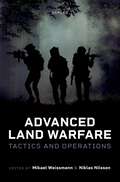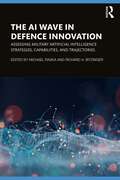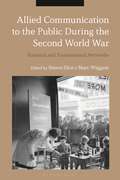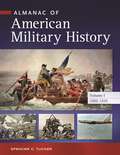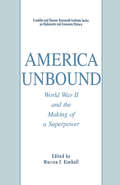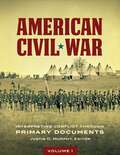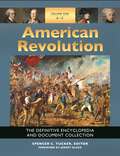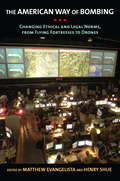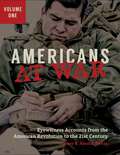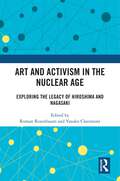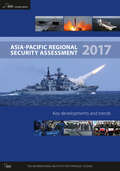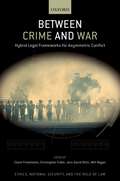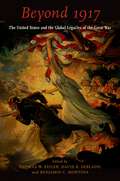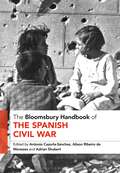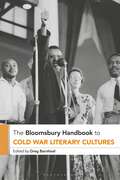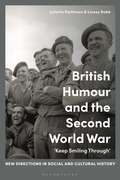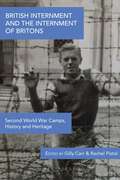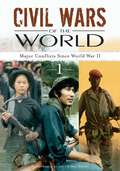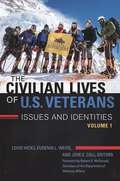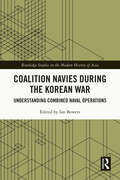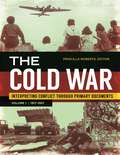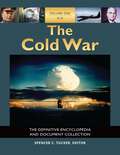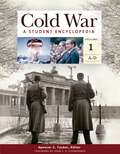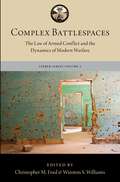- Table View
- List View
Advanced Land Warfare: Tactics and Operations
International politics have become ever more volatile over the last decade, increasing the risk of large-scale military violence. Yet the precise character of future war will depend on a range of factors that relate to adversaries, allies, technology, geographical scope and multiple domains of warfighting. Few would question that land forces will be important also in the foreseeable future. However, given that the battlefield is in a state of transformation, so is the mission, purpose and utilization of land forces. Indeed, the future conduct of land warfare is subjected to serious and important questions in the face of large and complex challenges and security threats. Advanced Land Warfare explores the evolving role of land forces, paying particular attention to the changes that have taken place in the art of commanding and executing combat, as well as the role of rapid technological innovation and information dissemination in shaping warfare. The book provides insights into key contemporary developments in land warfare and presents case studies on land tactics and operations in different national contexts, drawing on the best of theory, practice, and professional experience and featuring chapters written by leading international scholars and practitioners. Relating to the realities of the modern battlefield, the book addresses a number of critical questions about land tactics and operations, combining a conceptual basis with empirical examples of tactical thinking and practice and emphasising the importance of understanding the perspectives of various national armies, in order to provide a current understanding of the central issues of land warfare. An open access title available under the terms of a CC BY-NC-ND 4.0 International licence.
The AI Wave in Defence Innovation: Assessing Military Artificial Intelligence Strategies, Capabilities, and Trajectories
An international and interdisciplinary perspective on the adoption and governance of artificial intelligence (AI) and machine learning (ML) in defence and military innovation by major and middle powers. Advancements in AI and ML pose pressing questions related to evolving conceptions of military power, compliance with international humanitarian law, peace promotion, strategic stability, arms control, future operational environments, and technology races. To navigate the breadth of this AI and international security agenda, the contributors to this book include experts on AI, technology governance, and defence innovation to assess military AI strategic perspectives from major and middle AI powers alike. These include views of how the United States, China, Japan, South Korea, the European Union, and Russia see AI/ML as a technology with the potential to reshape military affairs and power structures in the broader international system. This diverse set of views aims to help elucidate key similarities and differences between AI powers in the evolving strategic context. A valuable read for scholars of security studies, public policy, and STS studies with an interest in the impacts of AI and ML technologies.
Allied Communication to the Public During the Second World War: National and Transnational Networks
In the Second World War, the home fronts of many countries became as important as the battle fronts. As governments tried to win and hold the trust of domestic and international audiences, communication became central to their efforts. This volume offers cutting-edge research by leading and emerging scholars on how information was used, distributed and received during the war. With a transnational approach encompassing Germany, Iberia, the Arab world and India, it demonstrates that the Second World War was as much a war of ideas and influence as one of machines and battles.Simon Eliot, Marc Wiggam and the contributors address the main communication problems faced by Allied governments, including how to balance the free exchange of information with the demands of national security and wartime alliances, how to frame war aims differently for belligerent, neutral and imperial audiences and how to represent effectively a variety of communities in wartime propaganda. In doing so, they reveal the contested and transnational character of the ways in which information was conveyed during the Second World War.Allied Communication during the Second World War offers innovative and nuanced perspectives on the thin border between information and propaganda during this global war and will be vital reading for World War II and media historians alike.
Almanac of American Military History [4 volumes]: [4 volumes]
This almanac provides a comprehensive, chronological overview of all American military history, serving as the standard reference work of its type.Almanac of American Military History is yet another reference work from acclaimed historian Dr. Spencer C. Tucker and ABC-CLIO, offering an unprecedented resource for a wide range of students and researchers. A comprehensive, four-volume title, this almanac traces all of American military history from the European voyages of discovery through 2011, chronicling the pivotal moments that have shaped the United States into the country it is today. In addition to documenting key events, this title presents biographies of more than 250 key individuals and provides information on more than 250 historically significant technologies and weapons systems.A detailed glossary is included, as are discussions of ranks and military awards and decorations. Divided into conflict periods, each chapter includes a detailed chronology, reference-entry sidebars, statistical information, primary-source documents, and a bibliography.
America Unbound: World War II and the Making of a Superpower (The World of the Roosevelts)
Whether World War II made or merely marked the transition of the United States from a major world power to a superpower, the fact remains that America's role in the world around it had undergone a dramatic change. Other nations had long recognized the potential of the United States. They had seen its power exercised regularly in economics, if only sparodically in politics. But World War II, and the landscape it left behind, prompted American leaders and the Congress to conclude that they had to use the nation's strength to protect and advance its interests.
American Civil War [2 volumes]: Interpreting Conflict through Primary Documents [2 volumes]
By providing detailed analyses of Civil War primary sources, this book will help readers to understand the history of the bloodiest of all American conflicts.This meticulously curated collection of primary source documents covers every aspect of the American Civil War, from its origins to its bloody engagements, all the way through the Reconstruction period. With approximately 300 primary sources, this comprehensive set includes orders and reports of significant battles, political debates and speeches, legislation, court cases, and literary works from the Civil War era. The documents provide insight into the thinking of all participants, drawing upon a vast range of sources that offer both a Northern and Southern perspective.The book gives equal treatment to the Eastern and Western Theaters and to Union and Confederate sources, and the primary sources are presented in chronological order, making it easy for readers to compare and contrast documents as the key events of the conflict unfold. Each primary source begins with an introduction that sets the document in its proper context and concludes with an analysis of the document that will help students to understand the document's significance.
American Revolution [5 volumes]: The Definitive Encyclopedia and Document Collection [5 volumes]
With more than 1,300 cross-referenced entries covering every aspect of the American Revolution, this definitive scholarly reference covers the causes, course, and consequences of the war and the political, social, and military origins of the nation.This authoritative and complete encyclopedia covers not only the eight years of the American Revolutionary War (1775–1783) but also the decades leading up to the war, beginning with the French and Indian War, and the aftermath of the conflict, with an emphasis on the early American Republic. Volumes one through four contain a series of overview essays on the causes, course, and consequences of the American Revolution, followed by impeccably researched A–Z entries that address the full spectrum of political, social, and military matters that arose from the conflict. Each entry is cross-referenced to other entries and also lists books for further reading. In addition, there is a detailed bibliography, timeline, and glossary.A fifth volume is devoted to primary sources, each of which is accompanied by an insightful introduction that places the document in its proper historical context. The primary sources help readers to understand the myriad motivations behind the American Revolution; the diplomatic, military, and political maneuvering that took place during the conflict; and landmark documents that shaped the founding and early development of the United States.
The American Way of Bombing: Changing Ethical and Legal Norms, from Flying Fortresses to Drones
Aerial bombardment remains important to military strategy, but the norms governing bombing and the harm it imposes on civilians have evolved. The past century has seen everything from deliberate attacks against rebellious villagers by Italian and British colonial forces in the Middle East to scrupulous efforts to avoid "collateral damage" in the counterinsurgency and antiterrorist wars of today. The American Way of Bombing brings together prominent military historians, practitioners, civilian and military legal experts, political scientists, philosophers, and anthropologists to explore the evolution of ethical and legal norms governing air warfare. Focusing primarily on the United States—as the world’s preeminent military power and the one most frequently engaged in air warfare, its practice has influenced normative change in this domain, and will continue to do so—the authors address such topics as firebombing of cities during World War II; the atomic attacks on Hiroshima and Nagasaki; the deployment of airpower in Iraq, Afghanistan, and Libya; and the use of unmanned drones for surveillance and attacks on suspected terrorists in Pakistan, Yemen, Sudan, Somalia, and elsewhere.
Americans at War [3 volumes]: Eyewitness Accounts from the American Revolution to the 21st Century [3 volumes]
This unprecedented compilation of eyewitness accounts records the thoughts and emotions of American soldiers spanning nearly 250 years of national history, from the American Revolution to the Afghanistan War.Understanding primary sources is essential to understanding warfare. This outstanding collection provides a diverse set of eyewitness accounts of Americans in combat throughout U.S. history. Offering riveting true stories, it includes accounts from participants in the American Revolution, the War of 1812, the Indian Wars, the Mexican-American War, the Civil War, the Spanish American War and Philippine Insurrection, World War I, World War II, the Korean War, the Vietnam War, The Persian Gulf War, the Afghanistan War, and the Iraq War.Most eyewitness accounts of war currently available to the public are those of writers who enjoy higher military rank. Americans at War addresses this imbalance between officers' accounts and enlisted men's accounts by invoking oral history archives. Contextual essays and timelines allow the reader to place the accounts in time and place, while the entries themselves allow the reader to experience the thoughts and emotions of Americans who engaged in combat.
Art and Activism in the Nuclear Age: Exploring the Legacy of Hiroshima and Nagasaki
This book explores the contemporary legacy of Hiroshima and Nagasaki following the passage of three quarters of a century, and the role of art and activism in maintaining a critical perspective on the dangers of the nuclear age. It closely interrogates the political and cultural shifts that have accompanied the transition to a nuclearized world. Beginning with the contemporary socio-political and cultural interpretations of the impact and legacy of the destruction of Hiroshima and Nagasaki, the chapters examine the challenges posed by committed opponents in the cultural and activist fields to the ongoing development of nuclear weapons and the expanding industrial uses of nuclear power. It explores how the aphorism that ‘all art is political’ is borne out in the close relation between art and activism. This multi-disciplinary approach to the socio-political and cultural exploration of nuclear energy in relation to Hiroshima/Nagasaki via the arts will be of interest to students and scholars of peace and conflict studies, social political and cultural studies, fine arts, and art and aesthetic studies.
Asia-Pacific Regional Security Assessment 2017
This book offers an analysis of the four central regional security themes relevant to the policy-focussed discussions at the annual IISS Shangri-La Dialogue. Namely: The evolving roles of the United States and China in Asia-Pacific security;Responses by the US and regional states to regional security tensions, particularly in the South China Sea;Emerging security questions relating to nuclear weapons, missiles and military cyber capabilities;The prospects for regional security cooperation, including the challenges for the ASEAN-centred architecture.
Between Crime and War: Hybrid Legal Frameworks for Asymmetric Conflict (ETHICS NATIONAL SECURITY RULE LAW SERIES)
The threat posed by the recent rise of transnational non-state armed groups does not fit easily within either of the two basic paradigms for state responses to violence. The civilian paradigm focuses on the interception of demonstrable immediate threats to the safety of others. The military paradigm focuses on threats posed by collective actors who pose a danger to the state's ability to maintain basic social order and, at times, the very existence of the state. While the United States has responded to the threat posed by non-state armed groups by using tools from both paradigms, it has placed substantially more emphasis on the military paradigm than have other states. While several reasons may contribute to this approach, one may be the assumption that a state must use each set of tools strictly according in accordance with the principles that underlie each paradigm. Implicit in this assumption may be the sense that the only alternative to the civilian paradigm is the unqualified military one. The chapters in this book suggest, however that we need not see the options as confined to this binary choice. It may be profitable to consider borrowing elements from each paradigm on some occasions to act more expansively than the conventional civilian paradigm allows, but less expansively than the conventional military paradigm would permit. At the same time, the mixing of the categories comes with its own ethical and legal risks that should be scrutinized.
Beyond 1917: The United States and the Global Legacies of the Great War
A massively destructive and transformative event, the First World War left in its wake many legacies. Beyond 1917 explores both the consequences of the war for the United States (and the world) and American influence on shaping the legacies of the conflict in the decades after US entry in 1917. From the fields, seas, and airspace of battle, we live today with the consequences of the Great War's poison gas, post-traumatic stress disorder, and technological inventions such as air bombardment of civilians, submarine and tank warfare, and modern surgical techniques. Conscription, pacifism, humanitarian campaigns, and socialist movements emerged from the war to shape politics within countries for decades to come. Governments learned the value of propaganda, both in print and in film. Society changed: women were emancipated in some countries and citizenship was altered in many places, while aristocracy and monarchies went into decline. European empires were transformed and in some cases destroyed; in the Middle East, the change was enormous, beginning with the final collapse of Ottoman hegemony in the region. Fascism and communism, mass migration, independence, militarism, an influenza epidemic, the rise of Wall Street and American economic power, a slowdown in the process of globalization, and the pursuit of world peace by an organization based on collective security numbered among the most significant and lasting legacies of this conflict. Beyond 1917 explores how and why the war has become an integral milepost for human history, reflects the importance of the conflict, the forces that led to it, and the forces it unleashed. On the occasion of the centennial commemorations, an international group of scholars considers the long-term policy, political, social, economic, and cultural consequences of the war for the United States itself and for the world. In addition to interpretive essays, the volume provides a comprehensive bibliography and timeline of events.
The Bloomsbury Handbook of the Spanish Civil War (Bloomsbury Handbooks)
In 25 innovative thematic essays, The Bloomsbury Handbook of the Spanish Civil War sees an interdisciplinary team of scholars examine a conflict that, more than 80 years after its conclusion, continues to generate both scholarly and public controversy.Split into four main sections covering Military and Diplomatic Issues, Society and Culture, Politics, and Debates, the volume offers a number of unique features. It is unprecedented in its comprehensiveness and includes chapters on topics that are rarely, if ever, explored in the literature of the field: humanitarianism, children and families, material conditions, the decimation of elites, archives and sources, archaeological approaches, digital approaches, public history, and cultural studies approaches. Instead of discussing each of the two warring sides, Republicans and Francoists, separately, as is so often the case, the book's thematic structure means that these opposing forces are examined together, facilitating comparison and fresh understanding in numerous areas of study. Contributors from the UK, the USA, Canada, Spain and Denmark also analyse the major controversies and disputes surrounding each topic as part of a detailed exploration of one of the seminal events of the 20th century.
The Bloomsbury Handbook to Cold War Literary Cultures (Bloomsbury Handbooks)
Adopting a unique historical approach to its subject and with a particular focus on the institutions involved in the creation, dissemination, and reception of literature, this handbook surveys the way in which the Cold War shaped literature and literary production, and how literature affected the course of the Cold War. To do so, in addition to more 'traditional' sources it uses institutions like MFA programs, university literature departments, book-review sections of newspapers, publishing houses, non-governmental cultural agencies, libraries, and literary magazines as a way to understand works of the period differently. Broad in both their geographical range and the range of writers they cover, the book's essays examine works of mainstream American literary fiction from writers such as Roth, Updike and Faulkner, as well as moving beyond the U.S. and the U.K. to detail how writers and readers from countries including, but not limited to, Taiwan, Japan, Uganda, South Africa, India, Cuba, the USSR, and the Czech Republic engaged with and contributed to Anglo-American literary texts and institutions.
British Humour and the Second World War: ‘Keep Smiling Through’ (New Directions in Social and Cultural History)
This book skilfully combines cutting-edge historical research by leading and emerging researchers in the field to investigate the utilization of British humour during the Second World War as well as its legacy in British popular culture.Juliette Pattinson and Linsey Robb bring together case studies that address a variety of situations in which humour was generated, including wartime jokes, films, radio, cartoons and private drawings, as well as post-war recollections, museum exhibitions and television comedy. By adopting an original interpretative framework of various wartime and post-war sites, this books opens up the possibility for a more variegated, richer analysis of Britain's wartime experience and its place thereafter in the cultural imagination.Through the lens of humour, this book promises to add critical nuance to our understanding of the functioning of British wartime society. Covering sources such as The British Cartoon Archive, BBC World War II People's War Archive and The Ministry of Information, and including analysis of the lasting role of comedy in Britain's memories and depictions of the war, the result is a rich addition to existing literature of use to students and scholars studying the cultural history of war.
British Internment and the Internment of Britons: Second World War Camps, History and Heritage
This edited volume presents a cutting-edge discussion and analysis of civilian 'enemy alien' internment in Britain, the internment of British civilians on the continent, and civilian internment camps run by the British within the wider British Empire. The book brings together a range of interdisciplinary specialists including archaeologists, historians, and heritage practitioners to give a full overview of the topic of internment internationally.Very little has been written about the experience of interned Britons on the continent during the Second World War compared with continentals interned in Britain. Even fewer accounts exist of the regime in British Dominions where British guards presided over the camps. This collection is the first to bring together the British experiences, as the common theme, in one study. The new research presented here also offers updated statistics for the camps whilst considering the period between 1945 to the present day through related site heritage issues.
Civil Wars of the World [2 volumes]: Major Conflicts since World War II [2 volumes]
This unique two-volume reference is the most authoritative, up-to-date resource available for information and data on the most volatile civil wars around the globe since World War II.At a time when historians are devoting more and more research to conflicts within nations, Civil Wars of the World: Major Conflicts since World War II is an invaluable addition to the available resources. In two volumes, it ranges around the globe to cover the most volatile and deadly civil wars of the past 60 years, including the bloody impasses in the Middle East; devastating tribal warfare in Africa; Cold War–fueled conflicts in Eastern Europe and Asia; the seemingly unbreakable cycle of rebellion and repression in some regions of Latin America; and more.Civil Wars of the World moves country by country to describe the causes, course, and consequences of internal conflicts within each nation. Coverage includes the historical background of each country, geographic and economic factors, descriptions of rebel groups and governments (e.g., regime type, size of military, capacity), terrorism, foreign and/or intergovernmental organization (IGO) intervention (UN, foreign support for rebels), foreign aid, and prospects for peace.
The Civilian Lives of U.S. Veterans [2 volumes]: Issues and Identities [2 volumes]
In this book, 50 experts study the lives of U.S. veterans at work, at home, and in American society as they navigate issues regarding health, gender, public service, substance abuse, and homelessness.The aftermath of modern war includes a population of veterans whose needs last for many decades—far longer than the war itself. This in-depth study looks at life after the military, considering the dual conundrum of a population benefiting from the perks of their duty, yet continuing to deal with trauma resulting from their service, and of former servicemen and servicewomen trying to fit into civilian life—in a system designed to keep them separate. Through two comprehensive volumes, essays shed light on more than 30 topics involving or affecting former servicemen and servicewomen, offering a blueprint for the formal study of U.S. veterans in the future. Contributions from dozens of experts in the field of military science cover such issues as unemployment, homelessness, disability, access to higher education, health, media portrayal, criminal justice, substance abuse, guns, suicide, and politics. Through information gleaned from surveys, interviews, participant observations, secondary analyses, and content analyses, the chapters reveal how veterans are able to successfully contribute to civilian life and show how the American workforce can benefit from their unique set of skills.
Coalition Navies during the Korean War: Understanding Combined Naval Operations (Routledge Studies in the Modern History of Asia)
This book presents a detailed assessment of the role of navies in the Korean War. It highlights that, despite being predominantly a land war, navies played a vital part. Moreover, the naval war was not solely a U.S. operation. Smaller navies from many countries made important contributions both in supporting the United States and carrying out independent and combined naval operations. This subject holds special importance since current Western strategic thinking and capabilities emphasise the necessity of combined naval operations involving multiple navies in any potential future naval conflict. The example set by the Korean War therefore offers valuable insights into the operational and strategic problems, and benefits and opportunities of contemporary and future combined coalition naval operations.
The Cold War [2 volumes] [2 volumes]: 2 volumes [2 volumes]
This detailed two-volume set tells the story of the Cold War, the dominant international event of the second half of the 20th century, through a diverse selection of primary source documents.One of the most extensive to date, this set of primary source documents studies the Cold War comprehensively from its beginning, with the emergence of the world's first communist government in Russia in late 1917, to its end, in 1991. All of the key events, including the Berlin Blockade, the Korean War, the Cuban Missile Crisis, the Vietnam War, and the nuclear arms race, are discussed in detail. The primary sources provide insight into the thinking of all participants, drawing on Western, Soviet, Asian, and Latin American perspectives.In The Cold War: Interpreting Conflict through Primary Documents primary documents are organized chronologically, allowing readers to appreciate the ramifications of the Cold War within a clear time frame. Extensive interpretive commentary provides in-depth background and context for each document. This work is an indispensable reference for all readers seeking to become deeply knowledgeable about the Cold War.
The Cold War [5 volumes]: The Definitive Encyclopedia and Document Collection [5 volumes]
This sweeping reference work covers every aspect of the Cold War, from its ignition in the ashes of World War II, through the Berlin Wall and the Cuban Missile Crisis, to the collapse of the Soviet Union in 1991.The Cold War superpower face-off between the Soviet Union and the United States dominated international affairs in the second half of the 20th century and still reverberates around the world today. This comprehensive and insightful multivolume set provides authoritative entries on all aspects of this world-changing event, including wars, new military technologies, diplomatic initiatives, espionage activities, important individuals and organizations, economic developments, societal and cultural events, and more. This expansive coverage provides readers with the necessary context to understand the many facets of this complex conflict.The work begins with a preface and introduction and then offers illuminating introductory essays on the origins and course of the Cold War, which are followed by some 1,500 entries on key individuals, wars, battles, weapons systems, diplomacy, politics, economics, and art and culture. Each entry has cross-references and a list of books for further reading. The text includes more than 100 key primary source documents, a detailed chronology, a glossary, and a selective bibliography. Numerous illustrations and maps are inset throughout to provide additional context to the material.
Cold War [5 volumes]: A Student Encyclopedia [5 volumes]
The most comprehensive and up-to-date student reference on the Cold War, offering expert coverage of all aspects of the conflict in a richly designed format, fully illustrated to give students a vivid sense of life in all countries affected by the war.ABC-CLIO is proud to announce the latest addition to its widely acclaimed legacy of historical reference works for students. Under the direction of internationally known expert Spencer Tucker, Cold War: A Student Encyclopedia captures the vast scope, day-to-day drama, and lasting impact of the Cold War more clearly and powerfully than any other student resource ever published.Ranging from the end of the Second World War to the collapse of the Soviet Union, Cold War: A Student Encyclopedia offers vivid portrayals of leading individuals, significant battles, economic developments, societal/cultural events, changes in military technology, and major treaties and diplomatic agreements. The nearly 1,100 entries, plus topical essays and a documents volume, draw heavily on recently opened Russian, Eastern European, and Chinese archives. Enhanced by a rich program of maps and images, it is a comprehensive, current, and accessible student reference on the dominant geopolitical phenomenon of the late-20th century.
Commemorating Race and Empire in the First World War Centenary (Provence University Press)
First World War commemoration in Europe has been framed as a moment of national trial and as a collective European tragedy. But the ‘Great War for Civilisation’ was more than just a European conflict. It was in fact a global war, a clash of empires that began a process of nationalist agitation against imperial polities and the racisms that underpinned them in Asia, Africa and beyond. Despite the global context of Centenary commemorative activity these events remain framed by national and state imaginaries and ones in which the ideas about nation, race and imperialism that animated and dominated men and women during the Great War sit uncomfortably with modern sensibilities. By drawing on original archival research, translations from French and Mandarin into English and by employing multidisciplinary conceptual frames of analysis this exciting and innovative volume explores how race and empire, and racism and imperialism, were commemorated or forgotten during the First World War Centenary.
Complex Battlespaces: The Law of Armed Conflict and the Dynamics of Modern Warfare (The Lieber Studies Series)
The conduct of warfare is constantly shaped by new forces that create complexities in the battlespace for military operations. As the nature of how and where wars are fought changes, new challenges to the application of the extant body of international law that regulates armed conflicts arise. This inaugural volume of the Lieber Studies Series seeks to address several issues in the confluence of law and armed conflict, with the primary goal of providing the reader with both academic and practitioner perspectives. Featuring chapters from world class scholars, policymakers and other government officials; military and civilian legal practitioners; and other thought leaders, together they examine the role of the law of armed conflict in current and future armed conflicts around the world. Complex Battlespaces also explores several examples of battlespace dynamics through four "lenses of complexity": complexity in legal regimes, governance, technology, and the urbanization of the battlefield.
